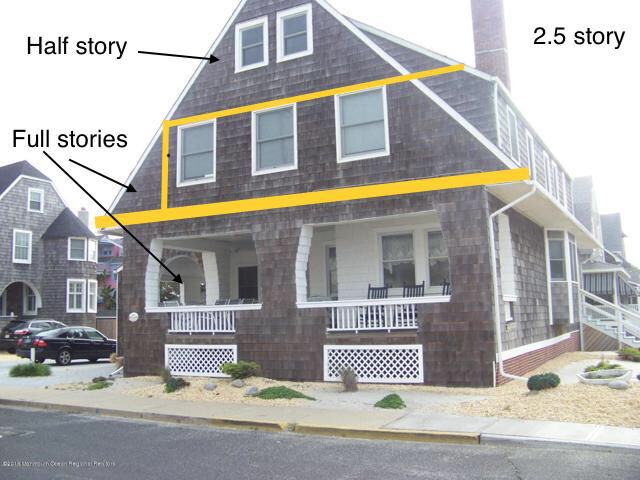The Half-Story
There will always be debatable hot topics in the fire service, fog vs smooth, interior vs exterior, wood ladders, metal ladders, this helmet vs that one etc etc etc. These debates exist because of they’re subjectivity thus its impossible to definitively be right or wrong. One recent topic that has peaked my interest when talked about is half story construction. Most notably because it’s not a debate at all or at least shouldn’t be anyways. Terminology in the fire service can be a source of debate all in itself with its endemic vernacular, trade jargon and slang. That’s what makes this particular topic even more intriguing. It Is not a firefighting term at all, it Is an architectural term used in a firefighting context. This is important because due to the fact it’s not a subjective jargon it can conversely be defined with objective terminology making it either right or wrong. There’s no grey area with half story construction, it either is or it is not and that’s where things start to get uncomfortable in conversation especially if you’re a Chief who’s department has been sizing up buildings inaccurately your entire career.
…my response to them is “you’re the reason why this problem exists”…
Now one might say in defense that their department considers half stories a “full story” or “attics” and I my response to them is “you’re the reason why this problem exists”. By taking a well defined architectural term and incorrectly applying it as jargon only creates needless problems for our trade and honestly it makes you sound uneducated. Now you might ask yourself why does this even matter? Why does knowing how to correctly identify this type of construction offer any value at all? Because of two very important characteristics of half story construction, knee walls and roof type. Most notably the top floor voids inherently created by knee walls that you won’t encounter in a full story. Top floor fires in half story construction are a game changer to any IC. These construction features set up a very dangerous set of conditions that are covered here in great detail… Killer in the Attic: Fire Operations in Half-Stories
The point of this article is to address the knowledge gap of identifying half stories on arrival and what the actual definition of one is. I’ve made several social media posts in the past using all sorts of visual aids and graphics to some avail. There always seems to be a portion of the audience that are either still confused or not in agreement so it’s time we clear the air and get the facts straight. A lot of the confusion can be addressed locally by becoming intimately familiar with your building stock. There’s all sorts of misleading characteristics in half stories. False dormers, split floor levels, attic windows and in some cases a hybrid full story and half story construction in the same building typically a loft over an attached garage. All these things can be ruled out or expected if you’re familiar with the buildings in your area. I know in mine 99% of the time what appears to be a half story is a half story, but it’s because I know false dormers or split levels among others aren’t prevailing construction features in my city.
The Size Up
The size up is integral, since building construction is the one uncontrollable factor of every fire ground that directly or indirectly controls everything on it. Knowledge and avoidance are the only tactics we can use for a dangerous building. Everything else… we have the tools to mitigate. When sizing up a building it is important to include half story in your radio traffic. This conveys to incoming units the inherent challenges and the fact you’re dealing with some sort of pitched roof. The limitation of any size up is it’s only as good as what you can see unless you have previous knowledge… ie a preplan. There are many exterior clues but ultimately the only definitive way to know you’re dealing with a half story containing a habitable space is by making entry. Using exterior indicators combined with local knowledge one can usually make a correct assessment from the outside. (yes, there are rare exceptions)
The Definition
Keep in mind you can have a half story without an occupied space on the top floor. Many get hung up or confused on this. The use of the space does not denote the definition, the construction features do. A half story is dependent on interior wall height and where the roof line terminates. You can have this space accessible by interior stairs but not used as livable space. This still means it’s a half story… and all the inherent problems of half stories will still be present due to how it’s framed not how it’s used. If the top floor doesn’t have full 8ft ceilings thus creating knee walls and the roof line terminates at floor level on the top story making the exterior walls part of the roof then it’s half story construction. If you Google half story definition you’ll get multiple versions of the same basic terminology. Most are used in the home appraisal industry. Keep in mind any height can be a half story you can have a 95 and a half story building depending on its top floor construction. Do not confuse this definition with attics. In North America an attic is a non habitable space for storage inaccessible by stairs. In Europe attics that doubled as living space were called garrets. That’s where some of the confusion starts. Attics have different definitions depending on era and region. Half stories can have attics also and most do, accessible by a small attic scuttle and only used for running utilities or limited storage.
Exterior Indicators
As already covered the big indication of half story construction is where the roof line terminates. If the rooflines above the top floor windows contain 8ft walls then it’s a full story. If it’s at floor level of the top story then it’s a half story. Your attention should be on the top floor. That’s where all your exterior indicators will be. The next big clue are dormer windows, yes there are false dormers but that’s why you rule this out by the presence of gable windows. I have never known anyone to hang a false gable window into a gable wall, that would be asinine. False dormers are usually smaller, without curtains and are accompanied by gable attic vents. If you have large dormer windows with side gable windows that’s a enough indication to include half story in a size up. It’s always better to err on the side off caution than not. There are indicators of living space also. These will be blinds, curtains, lamps and window AC units. Typically people don’t put those in attic windows.
The following are some photos with notations for reference and to show the variance of architectural styles of half stories.









All things considered there’s always exceptions but by combining multiple pieces of information one can be confident they’re making an accurate size up. I hope this article has helped those with difficulty identifying half story construction.
